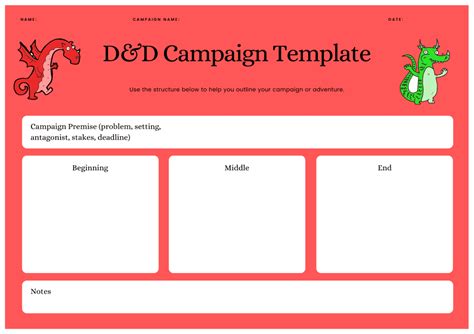Campaign organization is a crucial aspect of any Dungeons & Dragons (D&D) adventure. A well-structured and organized campaign can elevate the overall gaming experience for both the players and the Dungeon Master (DM). With the numerous details to keep track of, from character backstories to plot twists, a solid organizational system is essential. This article explores the world of campaign organization using Google Docs, providing a comprehensive guide on how to create and maintain an organized D&D campaign.
Benefits of Using Google Docs for Campaign Organization
Before diving into the nitty-gritty of creating a Google Doc template for campaign organization, it's essential to understand the benefits of using this platform. Google Docs offers several advantages that make it an ideal choice for D&D campaign organization:
- Collaboration: Google Docs allows multiple users to collaborate in real-time. This feature is particularly useful for DMs who want to share information with their players or co-DMs.
- Accessibility: Google Docs can be accessed from anywhere with an internet connection, making it easy to work on your campaign organization from any device.
- Automatic Saving: Google Docs automatically saves changes, ensuring that you never lose your work.
- Version History: The version history feature allows you to track changes and revert to previous versions if needed.
Setting Up Your Google Doc Template
To create a comprehensive Google Doc template for your D&D campaign, follow these steps:
- Create a New Document: Log in to your Google account and navigate to Google Docs. Click on the "Blank" template to create a new document.
- Set Up the Template Structure: Create a clear structure for your document using headings and sections. A suggested outline might include:
- Campaign Overview
- World-Building
- Characters
- Quests and Plotlines
- NPCs
- Rules and Mechanics
- Session Notes
- Use Tables and Lists: Utilize tables and lists to organize information, such as character stats, NPC profiles, and quest details.
- Add Images and Maps: Include images and maps to help visualize your campaign world and key locations.

Organizing Your Campaign World
Your campaign world is the foundation of your D&D adventure. A well-organized world can help you create a more immersive experience for your players.
World-Building Essentials
When building your campaign world, consider the following essential elements:
- Geography: Describe the physical layout of your world, including continents, oceans, mountains, and forests.
- Climate: Define the climate and weather patterns of your world.
- History: Develop a rich history for your world, including major events and eras.
- Cultures: Create diverse cultures for your world, including customs, traditions, and values.

Managing Characters and NPCs
Characters and NPCs are a crucial part of any D&D campaign. Keeping track of their details can be overwhelming, but with a well-organized system, you can easily manage their information.
Character Profiles
Create a character profile template that includes the following information:
- Character Name: The name of the character.
- Class and Level: The character's class and level.
- Ability Scores: The character's ability scores.
- Skills: The character's skills and proficiency levels.
- Equipment: The character's equipment and gear.
- Backstory: A brief description of the character's backstory.

NPC Profiles
Create an NPC profile template that includes the following information:
- NPC Name: The name of the NPC.
- Role: The NPC's role in the campaign.
- Personality: A brief description of the NPC's personality.
- Motivations: The NPC's motivations and goals.
- Stats: The NPC's stats, including ability scores and skills.

Quests and Plotlines
Quests and plotlines are the driving force behind your D&D campaign. A well-organized system can help you keep track of your story and ensure a smooth flow of events.
Quest Templates
Create a quest template that includes the following information:
- Quest Name: The name of the quest.
- Objective: A brief description of the quest's objective.
- NPCs Involved: A list of NPCs involved in the quest.
- Rewards: The rewards for completing the quest.
- Challenges: The challenges and obstacles that players will face during the quest.

Rules and Mechanics
Rules and mechanics are the backbone of your D&D campaign. A well-organized system can help you keep track of the rules and ensure a smooth gameplay experience.
House Rules
Create a section for house rules, including any custom rules or modifications to the official rules.
Mechanics Cheatsheet
Create a mechanics cheatsheet that includes a summary of the game's mechanics, including combat, skill checks, and spellcasting.

Session Notes
Session notes are a crucial part of any D&D campaign. A well-organized system can help you keep track of your sessions and ensure a smooth flow of events.
Session Template
Create a session template that includes the following information:
- Session Name: The name of the session.
- Date: The date of the session.
- Summary: A brief summary of the session.
- NPCs: A list of NPCs encountered during the session.
- Quests: A list of quests completed or started during the session.







What is the best way to organize my D&D campaign?
+The best way to organize your D&D campaign is to use a combination of digital tools and physical notebooks. Consider using a Google Doc template to keep track of your campaign world, characters, quests, and session notes.
How do I create a character profile template?
+To create a character profile template, consider including the following information: character name, class and level, ability scores, skills, equipment, and backstory. You can use a table or list to organize the information.
What is the importance of session notes?
+Session notes are crucial for keeping track of your campaign's progress and ensuring a smooth flow of events. They can help you remember important details, such as NPC interactions and quest completions.
By following the guidelines outlined in this article, you can create a comprehensive Google Doc template for your D&D campaign organization. Remember to stay organized, use clear headings and sections, and take advantage of tables and lists to keep track of information. Happy adventuring!
